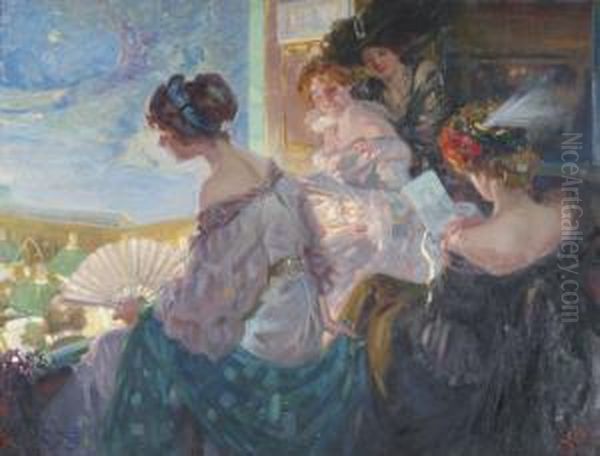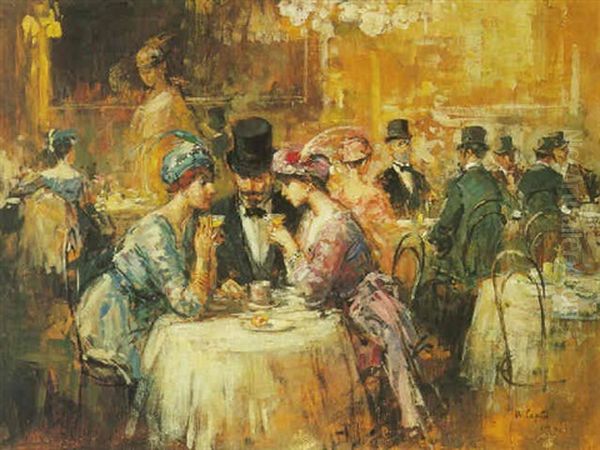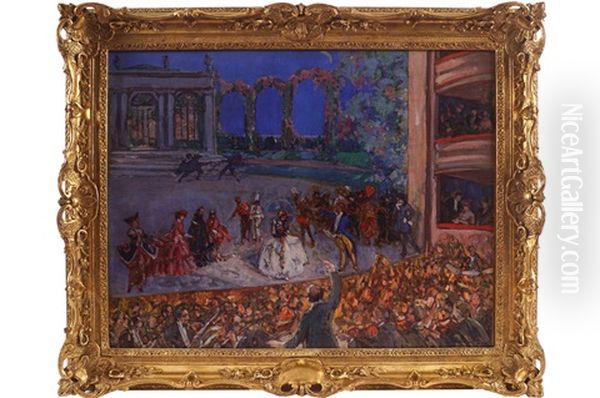Ulisse Caputo stands as a significant figure in Italian art history, an artist whose career bridged the late 19th and mid-20th centuries. Born in Salerno, Italy, in 1872, and passing away in 1948 at the age of 76, Caputo carved a distinct niche for himself with his captivating depictions of modern life, particularly focusing on the world of elegant women within sophisticated interior settings. His work is celebrated for its vibrant colour, sensitivity to light, and its unique synthesis of Italian artistic traditions with the innovations emanating from Paris, the undisputed centre of the art world during his most active years.
Caputo's journey as an artist began not far from his birthplace, in the bustling southern Italian city of Naples. This city, with its rich artistic heritage and vibrant contemporary scene, provided the foundational training that would shape his future path. He enrolled in the prestigious Accademia di Belle Arti di Napoli (Naples Academy of Fine Arts), a venerable institution that had nurtured generations of Italian artists.
During his time at the Academy, Caputo had the privilege of studying under influential figures. Among his teachers were Stanislao Lista, a sculptor and painter known for his adherence to academic principles, and Domenico Morelli, a towering figure in 19th-century Neapolitan painting. Morelli, in particular, was renowned for his historical and religious subjects, but also for his exploration of colour theory and his move towards a more realistic, yet emotionally charged style, which likely left an impression on the young Caputo.

However, Caputo's path diverged somewhat from a purely academic trajectory. Sources suggest he spent a period absorbing the lessons of the Academy but eventually sought out the more dynamic environment of a private studio. He began studying in the workshop of Gaetano Esposito, another prominent Neapolitan painter. Esposito was known for his genre scenes, portraits, and seascapes, often characterized by a rich application of paint and a keen interest in capturing the effects of light and atmosphere. This move suggests an early inclination towards the more modern, observational approaches gaining traction at the time, perhaps finding the direct engagement with contemporary life in Esposito's circle more stimulating.
The allure of Paris, the epicentre of artistic innovation and cultural life at the turn of the century, proved irresistible for many ambitious artists, and Ulisse Caputo was no exception. Around 1899 or 1900, he made the pivotal decision to relocate to the French capital. This move marked a significant turning point in his career, immersing him in an environment teeming with new ideas, diverse artistic movements, and unparalleled opportunities for exhibition and recognition.
Paris during the Belle Époque was a crucible of creativity. Impressionism had revolutionized painting decades earlier, and its legacy continued to evolve through Post-Impressionism, Fauvism, and the nascent stirrings of Cubism. Caputo arrived in a city where artists debated furiously, exhibited widely, and catered to a sophisticated clientele eager for depictions of modern life. He quickly integrated into this vibrant milieu, particularly connecting with the community of fellow Italian artists who had also sought their fortunes in Paris. Among these were figures like Lionello Balestrieri, known for his poignant depictions of artists and musicians.
Caputo did not simply observe the Parisian scene; he became an active participant and a recognized figure within it. He began exhibiting his work regularly, gaining attention for his distinctive style and subject matter. His ability to capture the specific ambiance of Parisian life, filtered through his Italian sensibility and training, resonated with audiences and critics, establishing him as an important expatriate artist contributing to the city's rich cultural tapestry.
A Synthesis of Styles: Impressionism Meets Divisionism
Ulisse Caputo's artistic style is perhaps best understood as a sophisticated fusion of different influences, primarily drawing from French Impressionism and Italian Divisionism (often related to Pointillism). He absorbed the Impressionists' fascination with capturing fleeting moments, the effects of light, and the use of vibrant, often unmixed colours applied with visible brushstrokes. This is evident in the luminosity and atmospheric quality of many of his paintings.

Simultaneously, Caputo incorporated techniques associated with Divisionism, an Italian movement that paralleled French Pointillism (exemplified by Georges Seurat and Paul Signac). Divisionists applied colour in small dots or strokes, believing that optical mixing in the viewer's eye would create more vibrant and luminous results than physically mixing pigments on the palette. Caputo adapted these principles, using broken brushwork and a careful juxtaposition of colours to enhance the brilliance and shimmering quality of light in his scenes, particularly effective in rendering artificial light in interiors or the textures of rich fabrics.
His Neapolitan training remained a subtle undercurrent. The emphasis on strong drawing learned under figures like Morelli provided a solid structure beneath the play of colour and light. Furthermore, the influence of 19th-century Italian realism, possibly absorbed through artists like Filippo Palizzi (whose work Caputo likely knew), grounded his depictions of figures and settings, preventing them from dissolving entirely into atmospheric effects.
Caputo was also receptive to other international trends. He admired the work of cosmopolitan artists like the American expatriate James Abbott McNeill Whistler, known for his tonal harmonies and elegant compositions, and the Swedish painter Anders Zorn, celebrated for his bravura brushwork and depictions of modern life and nudes. Some sources also mention an influence from the Spanish painter Ignazio Zuloaga (possibly the "Ignazio Zualzo" mentioned in initial sources), known for his dramatic portraits and scenes. This openness to diverse influences allowed Caputo to forge a style that was both contemporary and highly personal.
A significant encounter that further shaped his palette occurred with the American Impressionist painter Richard E. Miller, another prominent member of the Parisian art scene known for his decorative paintings of women in sunlit interiors. Interaction with Miller reportedly encouraged Caputo to adopt an even brighter, more luminous range of colours, pushing his work further towards a vibrant, high-key aesthetic. This evolution is particularly noted after Caputo's travels, including a visit to Morocco, which often inspired artists to embrace bolder colours. An Orientalist flavour, reflecting a broader European fascination with North Africa and the Middle East, can also be detected in some of his works or thematic choices.
The World of Feminine Elegance
Thematically, Ulisse Caputo is most renowned for his depictions of women, particularly elegant figures drawn from the upper echelons of society. His canvases frequently transport the viewer into the intimate and sophisticated spaces of the Belle Époque: opulent theatre boxes, bustling cafes, chic salons, and private drawing rooms. These are not merely portraits, but carefully constructed genre scenes capturing the atmosphere and social rituals of the era.

His female subjects are often portrayed in moments of leisure or social interaction – attending a performance, engaged in conversation, playing music (like the piano), or simply reflecting in a quiet moment. They are typically adorned in fashionable attire, particularly evening gowns, which provided Caputo ample opportunity to showcase his skill in rendering luxurious fabrics, intricate details like lace and embroidery, and the play of light on silk, satin, and velvet. The textures are palpable, adding a tactile richness to the visual experience.
While celebrating elegance and beauty, Caputo's paintings often possess a romantic, sometimes subtly melancholic or introspective mood. He captured the ambiance of these interior spaces, paying close attention to the quality of light, whether the warm glow of gas lamps, the sparkle of chandeliers, or the softer illumination filtering through a window. This sensitivity to light was crucial in defining the form of his figures and creating the overall atmosphere of the scene. He masterfully differentiated between natural and artificial light sources, a key challenge embraced by Impressionist and Post-Impressionist painters like Edgar Degas, whose depictions of theatre and cafe life offer an interesting comparison.
Capturing Light, Weaving Color
Caputo's technical prowess was central to his success. His handling of light and colour was particularly distinctive. He embraced the Impressionist and Divisionist idea that colour could be independent of the object itself, defined more by the light falling upon it and the surrounding colours reflecting onto it. This led to paintings where shadows are not dull grays or blacks, but are composed of complementary colours, adding vibrancy to the entire composition.
His application of paint, often using short, distinct brushstrokes or dabs of colour, contributed to the shimmering, lively surface of his canvases. This technique allowed individual colours to retain their intensity while blending optically in the viewer's perception, creating effects of dazzling light and rich texture. He wasn't afraid of using a high-key, saturated palette, especially in his mature works, reflecting the influence of artists like Richard E. Miller and the general trend towards brighter colours in post-Impressionist painting.
The careful rendering of details, such as the patterns on wallpaper, the gleam of polished wood, or the intricate designs of jewellery and fabric, demonstrates a meticulous observational skill that complements his broader atmospheric effects. This balance between detailed representation and painterly freedom gives his work a unique appeal, capturing both the specifics of a scene and its overall sensory impression.
Notable Works and Recognition
Throughout his career, Ulisse Caputo produced a significant body of work, and several paintings are frequently cited as representative of his style and themes. Among these are:
Dans la loge du théâtre (In the Theatre Box): This subject, revisited by many artists of the period including Renoir and Degas, was a favourite of Caputo's. It allowed him to explore the interplay of artificial light, elegant attire, and the social dynamics of public leisure. His versions typically focus on the richly dressed women occupying the box, capturing the glamour and atmosphere of the theatre.
Woman at the Piano: Another recurring theme, depicting a woman in a domestic or salon setting engaged in playing music. These works often emphasize the intimacy of the scene and allow for explorations of interior light and detailed rendering of the figure and instrument.
Elegant Ladies: A general title that could apply to many of his works focusing on groups of women in social settings, showcasing fashion and sophisticated interaction.
Midnight Ladies: Suggests scenes set late at night, perhaps in cafes or after-hours gatherings, allowing for dramatic effects of artificial lighting.
La Veuve (The Widow): Exhibited at the Paris Salon in 1901, this work likely presented a more sombre or narrative subject, showcasing his versatility beyond purely decorative scenes.
Parisian Landscape (1948): Indicates his engagement with cityscape painting, likely rendered with his characteristic attention to light and atmosphere, even towards the end of his life.
Terrazzo and La Senna: These titles suggest outdoor scenes, perhaps views from a terrace or depictions of the Seine River in Paris, demonstrating his interest extended beyond interiors. The mention of specific market valuations for these works (estimated between 2500-4500 Euros at one point) highlights the continued collector interest in his oeuvre.
Caputo's talent did not go unnoticed. He achieved considerable success in major exhibitions across Europe and beyond. His participation in the prestigious Paris Salon was regular, culminating in significant recognition at the Salon des Artistes Français in 1909, where he was awarded both bronze and gold medals – a testament to his standing in the competitive Parisian art world.
He was also a regular exhibitor at the Venice Biennale, one of the most important international showcases for contemporary art, participating in editions such as those of 1907 and 1909. His work travelled widely, being shown in major exhibitions in London, Munich, Milan, Rome, and even further afield in cities like Cairo and Buenos Aires, as well as New York. This international exposure solidified his reputation and brought his unique vision of modern elegance to a global audience.
Context, Connections, and Personal Life
Ulisse Caputo occupied an interesting position, navigating between his Italian heritage and his adopted home in Paris. He remained connected to the Italian art scene, exhibiting in Italy and drawing upon Italian artistic traditions like Divisionism, championed by artists such as Giovanni Segantini and Gaetano Previati. Yet, his career was largely forged in France, placing him alongside other successful Italian expatriates in Paris, such as the celebrated society portraitist Giovanni Boldini or the earlier Impressionist Giuseppe De Nittis.
His artistic development was clearly shaped by interactions and influences. His teachers in Naples – Lista, Morelli, and Esposito – provided his foundation. In Paris, the dialogue with artists like Richard E. Miller was demonstrably impactful. His admiration for figures like Whistler and Zorn reveals his awareness of broader international currents. The relationships with fellow Italian artists in Paris, like Balestrieri, provided a supportive community.
On a personal level, his life in Paris brought him marriage. He met Susanna Moraglio, described in some sources as being connected to patrons of the arts (the Da Enzo family). This union is noted as having had a positive influence on his work, perhaps providing stability and support that fostered his creativity, particularly in his sensitive depictions of figures and his engagement with themes related to music and domesticity.
Anecdotes suggest his path wasn't always smooth. The story of him leaving the formal Academy environment in Naples to pursue study with Esposito hints at an independent spirit. Furthermore, the observation that his early works were perhaps not fully appreciated or understood during initial exhibitions in Naples and Milan contrasts with the acclaim he later found in Paris, suggesting his style may have been ahead of tastes in certain Italian circles at the time, or simply better suited to the cosmopolitan Parisian market.
Legacy and Enduring Appeal
Ulisse Caputo passed away in 1948, leaving behind a legacy as a skilled and sensitive chronicler of the Belle Époque. His work captures a specific moment in time, preserving the elegance, fashion, and social atmosphere of upper-class European life, particularly in Paris. His unique stylistic blend, merging the light and colour of Impressionism with the techniques of Divisionism and grounded in solid Italian draftsmanship, resulted in paintings that are both visually dazzling and compositionally sound.
His focus on intimate interior scenes and the lives of women distinguishes his work. While artists like Degas explored similar settings, Caputo brought his own Italian sensibility and perhaps a more overtly romantic or decorative approach. His paintings continue to be appreciated by collectors and art enthusiasts drawn to the charm and sophistication of the era he depicted. The consistent presence of his work in galleries and auctions, sometimes commanding respectable prices, attests to his enduring appeal.
In conclusion, Ulisse Caputo was more than just a painter of pretty pictures. He was a technically accomplished artist who successfully navigated the complex art world of the early 20th century. He absorbed diverse influences, synthesized them into a personal style, and created a body of work that vividly evokes the spirit of his time. As an Italian artist who found fame in Paris, he embodies the cross-cultural currents that enriched European art, leaving a distinct mark through his luminous and elegant depictions of modern life.